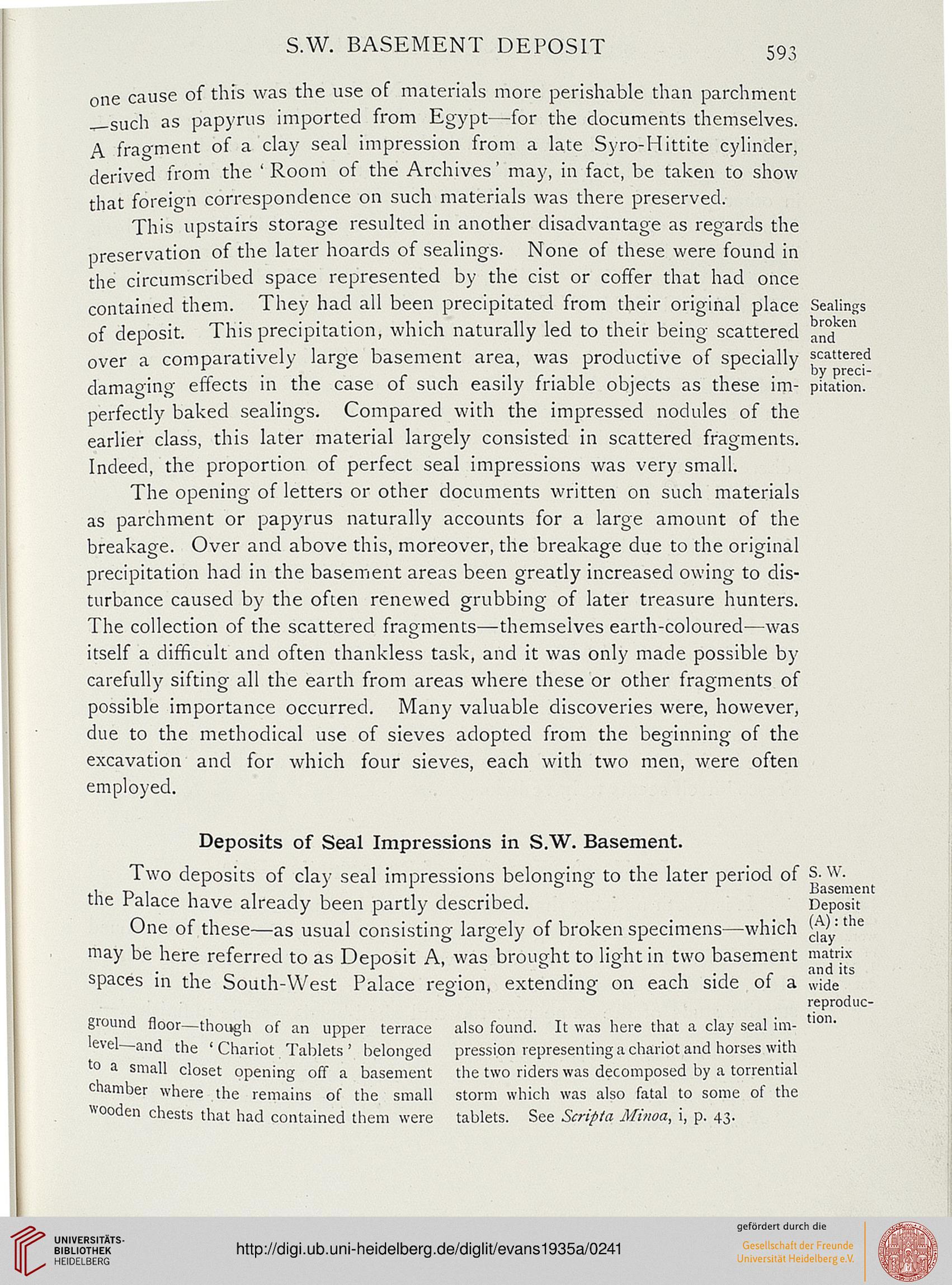S.W. BASEMENT DEPOSIT 593
one cause of this was the use of materials more perishable than parchment
—such as papyrus imported from Egypt—for the documents themselves.
A fragment of a clay seal impression from a late Syro-Hittite cylinder,
derived from the ' Room of the Archives' may, in fact, be taken to show
that foreign correspondence on such materials was there preserved.
This upstairs storage resulted in another disadvantage as regards the
preservation of the later hoards of sealing's. None of these were found in
the circumscribed space represented by the cist or coffer that had once
contained them. They had all been precipitated from their original place Sellings
broken
and
of deposit. This precipitation, which naturally led to their being scattered
over a comparatively large basement area, was productive of specially scattered
damaging effects in the case of such easily friable objects as these im- pitation.
perfectly baked sealings. Compared with the impressed nodules of the
earlier class, this later material largely consisted in scattered fragments.
Indeed, the proportion of perfect seal impressions was very small.
The opening of letters or other documents written on such materials
as parchment or papyrus naturally accounts for a large amount of the
breakage. Over and above this, moreover, the breakage due to the original
precipitation had in the basement areas been greatly increased owing to dis-
turbance caused by the often renewed grubbing of later treasure hunters.
The collection of the scattered fragments—themselves earth-coloured—was
itself a difficult and often thankless task, and it was only made possible by
carefully sifting all the earth from areas where these or other fragments of
possible importance occurred. Many valuable discoveries were, however,
due to the methodical use of sieves adopted from the beginning of the
excavation and for which four sieves, each with two men, were often
employed.
Deposits of Seal Impressions in S.W. Basement.
Two deposits of clay seal impressions belonging to the later period of S.W.
,, T, , , , , , , , ., , Basement
me 1 alace have already been partly described. Deposit
One of these—as usual consisting largely of broken specimens—which J.'|ay'K
may be here referred to as Deposit A, was brought to light in two basement matrix
and its
spaces in the South-West Palace region, extending on each side of a wide
reproduc-
ground floor—though of an upper terrace also found. It was here that a clay seal im- tK>"'
level and the ' Chariot Tablets ' belonged pressi.on representing a chariot and horses with
to a small closet opening off a basement the two riders was decomposed by a torrential
chamber where the remains of the small storm which was also fatal to some of the
wooden chests that had contained them were tablets. See Scrip/a Mima, i, p. 43.
one cause of this was the use of materials more perishable than parchment
—such as papyrus imported from Egypt—for the documents themselves.
A fragment of a clay seal impression from a late Syro-Hittite cylinder,
derived from the ' Room of the Archives' may, in fact, be taken to show
that foreign correspondence on such materials was there preserved.
This upstairs storage resulted in another disadvantage as regards the
preservation of the later hoards of sealing's. None of these were found in
the circumscribed space represented by the cist or coffer that had once
contained them. They had all been precipitated from their original place Sellings
broken
and
of deposit. This precipitation, which naturally led to their being scattered
over a comparatively large basement area, was productive of specially scattered
damaging effects in the case of such easily friable objects as these im- pitation.
perfectly baked sealings. Compared with the impressed nodules of the
earlier class, this later material largely consisted in scattered fragments.
Indeed, the proportion of perfect seal impressions was very small.
The opening of letters or other documents written on such materials
as parchment or papyrus naturally accounts for a large amount of the
breakage. Over and above this, moreover, the breakage due to the original
precipitation had in the basement areas been greatly increased owing to dis-
turbance caused by the often renewed grubbing of later treasure hunters.
The collection of the scattered fragments—themselves earth-coloured—was
itself a difficult and often thankless task, and it was only made possible by
carefully sifting all the earth from areas where these or other fragments of
possible importance occurred. Many valuable discoveries were, however,
due to the methodical use of sieves adopted from the beginning of the
excavation and for which four sieves, each with two men, were often
employed.
Deposits of Seal Impressions in S.W. Basement.
Two deposits of clay seal impressions belonging to the later period of S.W.
,, T, , , , , , , , ., , Basement
me 1 alace have already been partly described. Deposit
One of these—as usual consisting largely of broken specimens—which J.'|ay'K
may be here referred to as Deposit A, was brought to light in two basement matrix
and its
spaces in the South-West Palace region, extending on each side of a wide
reproduc-
ground floor—though of an upper terrace also found. It was here that a clay seal im- tK>"'
level and the ' Chariot Tablets ' belonged pressi.on representing a chariot and horses with
to a small closet opening off a basement the two riders was decomposed by a torrential
chamber where the remains of the small storm which was also fatal to some of the
wooden chests that had contained them were tablets. See Scrip/a Mima, i, p. 43.





